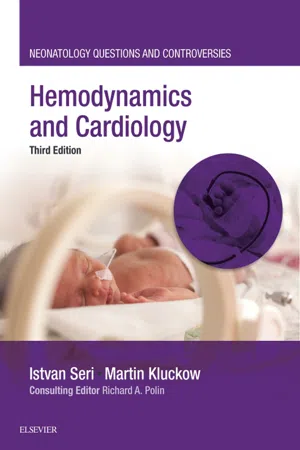
- 576 pages
- English
- ePUB (mobile friendly)
- Available on iOS & Android
About this book
Dr. Richard Polin's Neonatology Questions and Controversies series highlights the most challenging aspects of neonatal care, offering trustworthy guidance on up-to-date diagnostic and treatment options in the field. In each volume, renowned experts address the clinical problems of greatest concern to today's practitioners, helping you handle difficult practice issues and provide optimal, evidence-based care to every patient.- Stay fully up to date in this fast-changing field with Hemodynamics and Cardiology, 3rd Edition.- A new editorial team and a completely redesigned volume with state-of-the-art chapters on neonatal hemodynamics.- New chapters on the role of delayed cord clamping/cord milking, the relationship between neonatal transition and brain injury, the hemodynamics of the asphyxiated neonate, the hemodynamic impact of therapeutic hypothermia, and practical physiology-based approaches to the diagnosis and treatment of neonatal hypotension, PPHN and PDA.- A new section discusses comprehensive real-time monitoring of neonatal hemodynamics, and its role in the establishment of precision medicine in neonatology and the prediction of neonatal sepsis using mathematical modelling of heart rate variability.- Expanded sections review the clinical application of the tools available for bedside monitoring of systemic and organ blood flow and oxygen delivery and the approaches to the pathophysiology-based treatment of neonatal shock and outcomes.- Consistent chapter organization to help you find information quickly and easily.- The most authoritative advice available from world-class neonatologists who share their knowledge of new trends and developments in neonatal care. Purchase each volume individually, or get the entire 7-volume set!Gastroenterology and NutritionHematology, Immunology and GeneticsHemodynamics and CardiologyInfectious Disease and Pharmacology New Volume!Nephrology and Fluid/Electrolyte PhysiologyNeurologyThe Newborn Lung
Frequently asked questions
- Essential is ideal for learners and professionals who enjoy exploring a wide range of subjects. Access the Essential Library with 800,000+ trusted titles and best-sellers across business, personal growth, and the humanities. Includes unlimited reading time and Standard Read Aloud voice.
- Complete: Perfect for advanced learners and researchers needing full, unrestricted access. Unlock 1.4M+ books across hundreds of subjects, including academic and specialized titles. The Complete Plan also includes advanced features like Premium Read Aloud and Research Assistant.
Please note we cannot support devices running on iOS 13 and Android 7 or earlier. Learn more about using the app.
Information
Point of Care Ultrasound in the Assessment of the Neonatal Cardiovascular System
Abstract
Keywords
Table of contents
- Cover image
- Title page
- Table of Contents
- Series Editor
- Copyright
- Contributors
- Preface
- Series Foreword
- Part A. Developmental Cardiovascular Physiology and Pathophysiology
- Part B. Hemodynamic Principles of Postnatal Transition
- Diagnosis of Neonatal Cardiovascular Compromise: Methods and their Clinical Applications
- Clinical Presentations and Treatment of Cardiovascular Compromise in the Neonate
- Part E. Cardiology
- Index